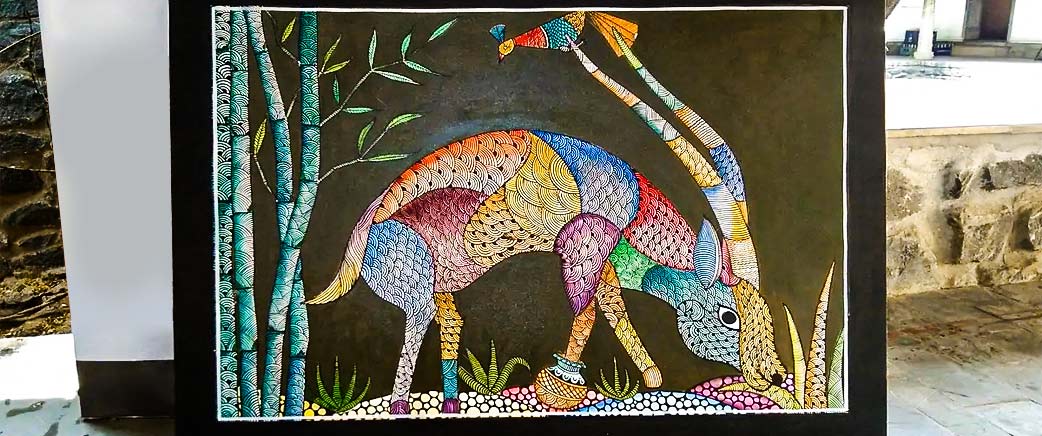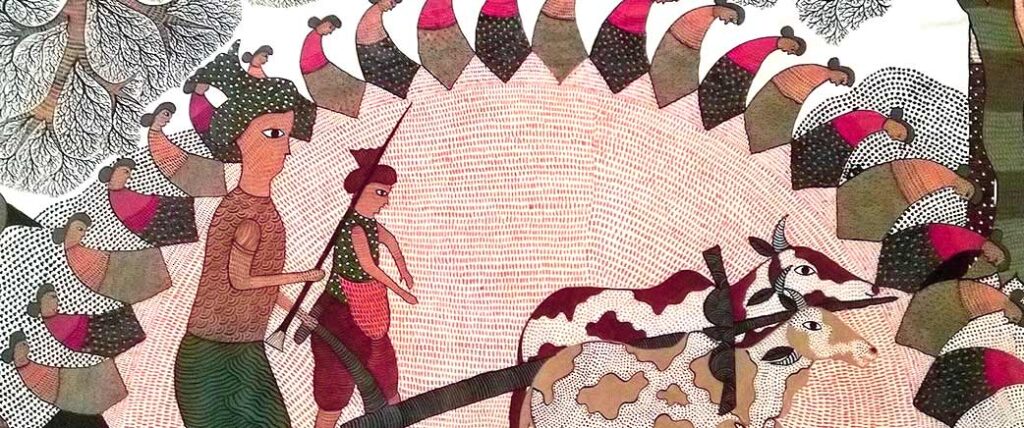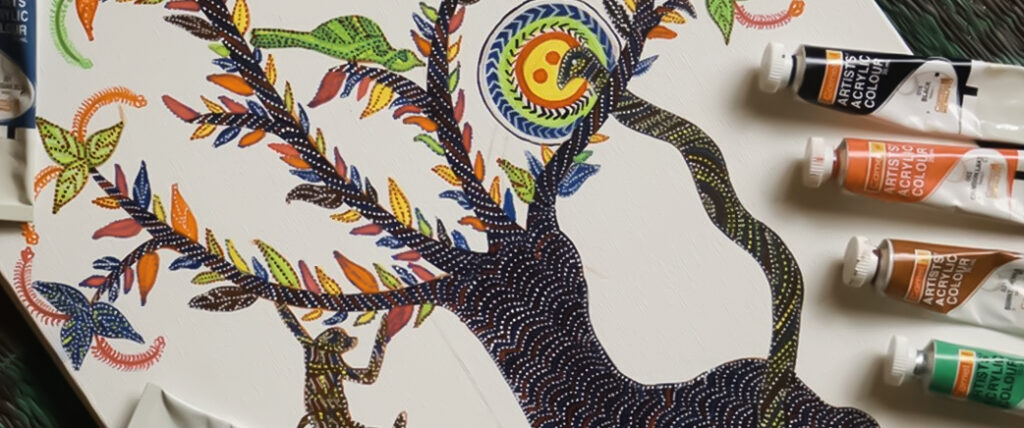
India is renowned for its cultural significance and remarkable diversity, which is reflected in its artistic heritage. One aspect of this rich tapestry is tribal culture, which has flourished in India for centuries. However, it is worth considering whether we have truly brought enough attention to this vibrant art form. In particular, Gond Art offers a fascinating glimpse into the world of tribal art in India, showcasing the extraordinary creations of Gond artists who draw inspiration from their folklores, anecdotes, and personal experiences. This unique folk art form encapsulates a captivating blend of cultural significance, diversity, intricate craftsmanship, and even occasional controversies.
Gond Tribe
Gond is an Indian tribe. The people of the Gond tribe are also known as the Gondi or Gond people. They address themselves as Koitur and speak Gondi, a Dravidian family’s unwritten language. This tribe is primarily found in the following Indian states: Madhya Pradesh, Chhattisgarh, Maharashtra, Andhra Pradesh, Gujarat, Jharkhand, Karnataka, Telangana, Uttar Pradesh, West Bengal, and Odisha
Gonds are subdivided into four tribes:
- Raj Gonds
- Madia Gonds
- Dhurve Gonds
- Khatulwar Gonds
Gond Paintings
Gond Paintings are a form of traditional art associated with the Gond tribe. This ancient art form dates back to the 13th to 19th century, although the exact origins remain unclear. The Gond tribe, predominantly residing in Central India, has been practicing this art as a means of expression and storytelling for generations. The paintings are characterized by vibrant colors, intricate patterns, and unique motifs, often depicting elements from nature, mythology, and daily life. While Gond art has gained recognition and popularity in recent years, its historical roots and development still hold some mysteries that add to the allure and intrigue of this beautiful tribal art form.

Themes in Gond Paintings
Gond Paintings, originating from the Gond tribe of Central India, encompass a wide range of themes that reflect the tribe’s cultural and spiritual beliefs. These themes are often depicted through intricate patterns and vibrant colors, creating visually captivating artworks. Some common themes found in Gond Paintings include:
1. Nature: Nature plays a significant role in Gond art. Artists depict forests, trees, animals, birds, and other natural elements with great reverence and detail. The artworks often symbolize the harmonious relationship between humans and nature, emphasizing the tribe’s deep connection to the environment.
2. Mythology and Folklore: Gond artists draw inspiration from their rich mythology and folklore. They depict gods, goddesses, and mythical creatures from their oral traditions, narrating tales of creation, heroic deeds, and celestial beings. These artworks serve as a medium to preserve and pass on their cultural heritage.
2. Mythology and Folklore: Gond artists draw inspiration from their rich mythology and folklore. They depict gods, goddesses, and mythical creatures from their oral traditions, narrating tales of creation, heroic deeds, and celestial beings. These artworks serve as a medium to preserve and pass on their cultural heritage.
3. Rituals and Celebrations: Gond Paintings often portray the tribe’s rituals, ceremonies, and festive celebrations. They capture the spirit of community gatherings, dances, music, and other cultural practices, showcasing the vibrant social fabric and joyous occasions within the Gond community.
4. Daily Life: Gond artists also depict scenes from their everyday lives, showcasing activities like farming, hunting, gathering, and village life. These paintings offer a glimpse into the simple yet profound aspects of their existence, celebrating the beauty and significance of mundane experiences.
5. Dreams and Imaginations: Gond art is known for its imaginative and dream-like quality. Artists often incorporate surreal and fantastical elements, depicting dreamscapes, mythical creatures, and abstract patterns. These artworks reflect the artist’s inner world and their ability to transcend reality.
6. Social Issues: In recent years, Gond artists have started incorporating contemporary themes and addressing social issues in their paintings. They use their art as a platform to raise awareness about topics such as environmental conservation, women’s empowerment, and societal challenges faced by their community.
4. Daily Life: Gond artists also depict scenes from their everyday lives, showcasing activities like farming, hunting, gathering, and village life. These paintings offer a glimpse into the simple yet profound aspects of their existence, celebrating the beauty and significance of mundane experiences.
5. Dreams and Imaginations: Gond art is known for its imaginative and dream-like quality. Artists often incorporate surreal and fantastical elements, depicting dreamscapes, mythical creatures, and abstract patterns. These artworks reflect the artist’s inner world and their ability to transcend reality.
6. Social Issues: In recent years, Gond artists have started incorporating contemporary themes and addressing social issues in their paintings. They use their art as a platform to raise awareness about topics such as environmental conservation, women’s empowerment, and societal challenges faced by their community.
Carving The Design Keyblock
After accurately transferring the drawing to the wooden panel. The artist begins to carve a drawing onto the panel. To carve the key block, the artist uses both a knife and gauges of various sizes. The artist uses a knife to make more exact cuts in regions of very fine detail. In order to speed up the carving process, gauges are used to remove the wood from greater regions all at once.

Process of Making Gond Paintings
The process of creating Gond Paintings involves several distinct steps, showcasing the meticulous craftsmanship and attention to detail by Gond artists. Here is an overview of the typical process:
2. Outlining: The next step is outlining the main design using a fine-tipped brush or pen. The outlines are typically bold and intricate, defining the shapes and forms of the elements in the artwork. Artists use black or dark-colored ink for this purpose.
6. Final Touches: Once the painting is complete, the artist adds finishing touches, enhancing the overall aesthetic appeal. This may include highlighting certain elements with metallic colors, adding intricate border designs, or incorporating additional details to create a cohesive and visually engaging artwork.
Gond Paintings are created with great precision and skill, with each artist infusing their personal style and creativity into the process. The end result is a captivating artwork that captures the essence of Gond tribal culture, folklore, and the artist’s unique interpretation of their surroundings.
1. Preparation: The artist begins by selecting a canvas for the painting, which is usually a piece of handmade paper or cloth. The surface is then prepared by applying a mixture of tamarind seed paste and water, which acts as a binder and provides a smooth base for painting.
2. Outlining: The next step is outlining the main design using a fine-tipped brush or pen. The outlines are typically bold and intricate, defining the shapes and forms of the elements in the artwork. Artists use black or dark-colored ink for this purpose.
3. Filling: Once the outlines are complete, the artist proceeds to fill in the intricate patterns and details within the design. Gond art is characterized by the use of vibrant colors, and artists employ natural pigments derived from minerals, plants, and charcoal. They mix the pigments with water or gum to create a consistent consistency for painting.
4. Dotting and Shading: Gond art is known for its distinctive dotting technique. Artists use a fine brush or a thin metal stick to create intricate patterns of dots within the design. This technique adds texture, depth, and visual interest to the painting. Shading is also incorporated to create a sense of dimension and highlight specific elements.
5. Symbolic Motifs: Gond artists incorporate symbolic motifs that hold cultural and spiritual significance. These motifs often represent elements from nature, tribal mythology, or everyday life. The artist carefully places these motifs within the composition, weaving a narrative through their arrangement.
4. Dotting and Shading: Gond art is known for its distinctive dotting technique. Artists use a fine brush or a thin metal stick to create intricate patterns of dots within the design. This technique adds texture, depth, and visual interest to the painting. Shading is also incorporated to create a sense of dimension and highlight specific elements.
5. Symbolic Motifs: Gond artists incorporate symbolic motifs that hold cultural and spiritual significance. These motifs often represent elements from nature, tribal mythology, or everyday life. The artist carefully places these motifs within the composition, weaving a narrative through their arrangement.
6. Final Touches: Once the painting is complete, the artist adds finishing touches, enhancing the overall aesthetic appeal. This may include highlighting certain elements with metallic colors, adding intricate border designs, or incorporating additional details to create a cohesive and visually engaging artwork.
Gond Paintings are created with great precision and skill, with each artist infusing their personal style and creativity into the process. The end result is a captivating artwork that captures the essence of Gond tribal culture, folklore, and the artist’s unique interpretation of their surroundings.




